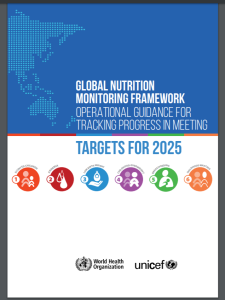Accelerating nutrition progress through target setting

In the wake of the Millennium Development Goals, the Sustainable Development Goals (SDGs) became a rallying point for the global nutrition community to accelerate actions towards reducing malnutrition. In 2012, the World Health Assembly (WHA) endorsed six Global Nutrition Targets for 2025.
The nutrition targets are supported by commitments for action including the Decade of Action on Nutrition. Like the WHA targets, the Decade of Action on Nutrition is a mechanism for nutrition stakeholders to consolidate and align actions on nutrition programs and initiatives. In order for countries and partners to align and commit to action, standards are needed for common indicators of progress.
What is the GNMF?
The Global Nutrition Monitoring Framework (GNMF) was approved by WHO Member States in 2014. The framework includes the six target indicators and 14 core indicators that track intermediate outcomes, processes, and policy.
All Member States are expected to regularly report on these 20 indicators. This requires high-quality comparable data across time and countries. However, many countries lack the systems to regularly collect and report on these indicators.

https://www.who.int/nutrition/publications/operational-guidance-GNMF-indicators/en/
GNMF measurement gaps
Data on the six global nutrition targets is unavailable or insufficient in many countries, particularly data on children overweight. The Global Nutrition Report tracks country-level nutrition targets and the data reported against these targets (the country tracking table is available here). Almost all countries use nationally-representative household surveys for these data, the frequency of which can vary widely from annual to every 3-5 years to as much as a decade or more.
Data for the 14 intermediate outcome, process and policy indicators varies widely in terms of source and availability. Intermediate outcomes include indicators of nutritional status as well as intervention coverage. Ideally these would also come from periodic nationally representative surveys but many of the indicators are not included in the most common platforms such as DHS or MICS. Intermediate outcomes including the coverage of breastfeeding counseling are not commonly collected in household surveys but was included as an indicator to help advocate for new data collection. A policy-related indicator is being used as an interim indicator. Most policy indicators including legislation or regulations implementing the International Code of Marketing of Breast-milk substitutes are pulled from NutriDash, UNICEF’s internal platform, which depends on annual reporting by UNICEF country offices or WHO country-level staff
 |
 |
 |
 |
How does DataDENT help fill these gaps?
DataDENT’s goal is to strengthen collection and use of nutrition data with a special focus on measuring the coverage of nutrition-specific interventions including breastfeeding counseling. We are also working on new indicators of nutrition sensitive intervention coverage and enabling environments for nutrition. In early 2019, we facilitated a process for making recommendations to the DHS Program about additions to the core questionnaire. We are currently building on that work to develop a core set of nutrition intervention coverage indicators and household survey module that can be used by a wide range of stakeholders. We expect to release the first public draft in Q4 2019 after review by WHO UNICEF TEAM.
